Several years ago, I came across
Derren Brown, the British magician and showman who proclaimed that he worked out a system where he could accurately predict the winner of any horse race every time, and he demonstrated this method in his TV show
“The System”. I won’t go into the details of Derren’s show in case you want to watch it yourself, but it is highly entertaining.
A Geological 'System'
I’m going to introduce you to my ‘System’, which is much simpler than Derren Brown’s system. It involves asking a simple question that every geologist understands. The answer is a choice between only two alternatives, so the odds are 50/50, just like choosing between black or white. The gamble is that you make a prior guess as to what choice the person will make, and you make money on correctly guessing their choice.
‘But how can we make money on a choice between two equal alternatives?’, you ask.
If you ask someone to choose between black or white, there’s a 50% probability for each of black or white. If you repeat this experiment many times, you cannot reliably win money over the long term, so a 50/50 choice is not a foolproof gambling system.
But amazingly, I’ve worked out a foolproof system based on a choice very much like a choice between black or white that’s guaranteed to make you money over the long term. It is not a scam and it’s so simple you can test it out on some geologist friends and colleagues immediately after you read this post.
However, instead of a choice between black or white, my ‘system’ is based on a geological choice. The question is:
“Imagine a single fold profile. Do you see a synform or an antiform?” Arts students are like computers
The choice between an antiform and a synform each has a 0.5 probability, so it’s identical to a choice between black or white. If you get a computer to randomly select between a synform and an antiform and do this experiment many times, the probability curve of the antiform bias would look like Figure 1. The peak of the bell curve sits right in between the synform and antiform options.
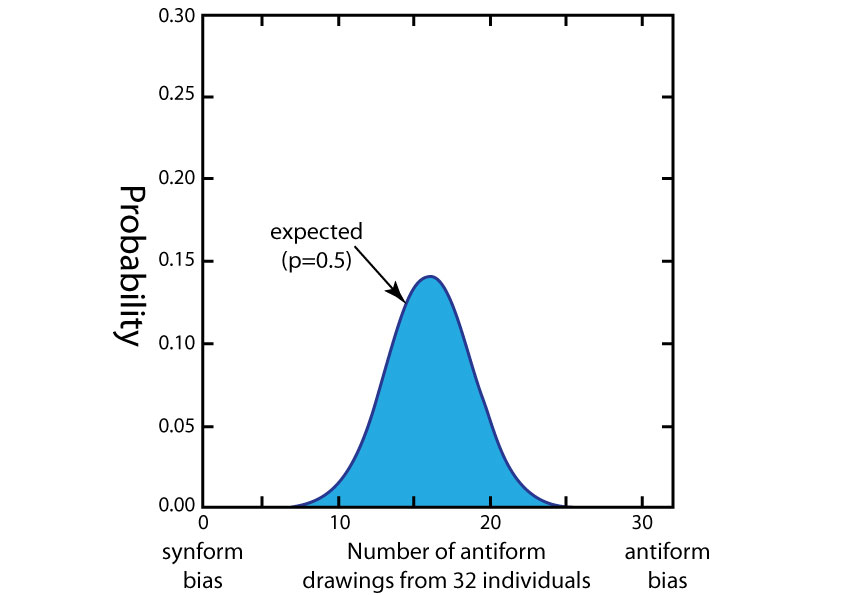 Figure 1
Figure 1
Even non-geologists who choose between synform or antiform produce results similar to these computer results (Figure 2).
 Figure 2
Figure 2
The results in Figure 2 are based on a 1998 experiment that I conducted on 32 University of Western Australia (UWA) Arts students who had no prior exposure to geology. The students had to complete the activity shown in Figure 3. Figure 4 shows a completed example.
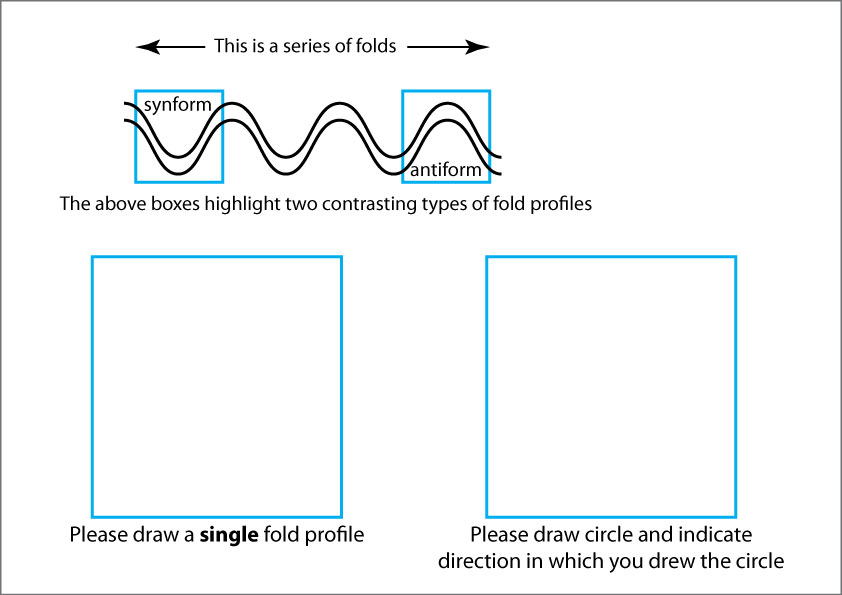 Figure 3
Figure 3 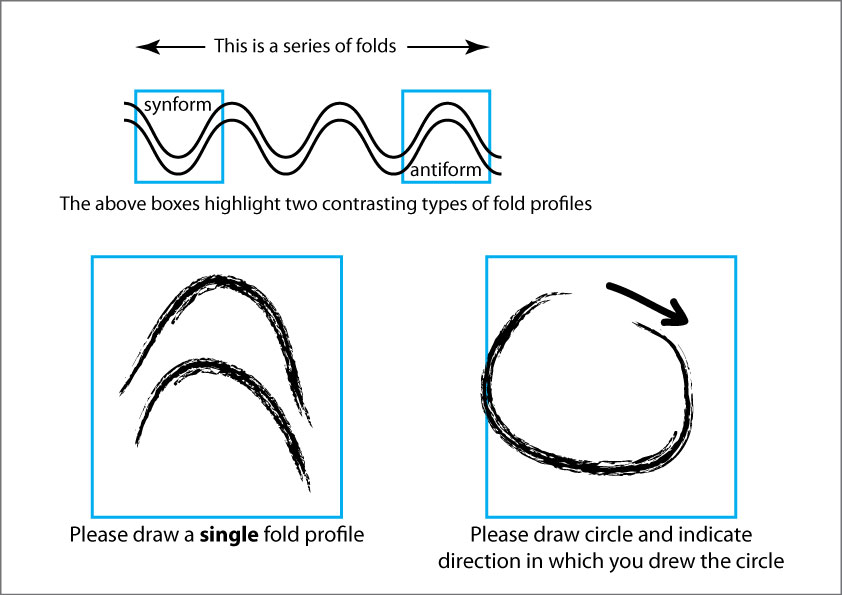 Figure 4. A completed activity sheet. The question about the circle was to see if there was a relationship between the type of fold drawn and the way people drew circles. There was no statistical relationship between the two.
Figure 4. A completed activity sheet. The question about the circle was to see if there was a relationship between the type of fold drawn and the way people drew circles. There was no statistical relationship between the two.
Geologists are not like computers
So, given that I know what to expect from a computer and a control group of non-geologists, how do you think geologists respond when asked the same question?
The result is illustrated in Figure 5. The pink bell curve shows a very strong antiform bias, and is the result of my 1998 experiment at UWA with 32 geology students and staff using the same activity shown in Figure 3.
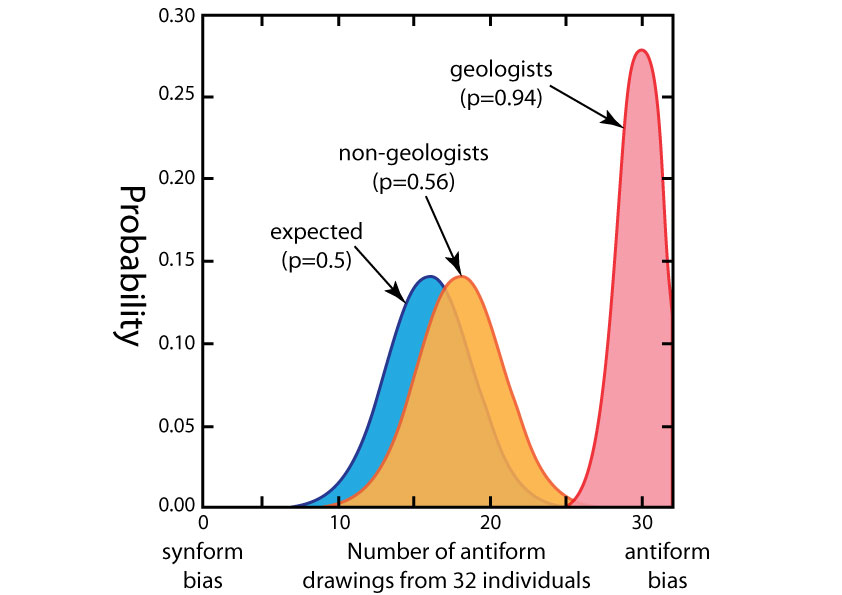 Figure 5
Figure 5
In fact, the results between the geologists and non-geologists are so different they can be considered two completely different populations. The overlap of the probability curves is so minimal that we are likely to get a biased result from geologists, no matter how many geologists we ask. The bell curve indicates that 9 out of 10 geologists, if asked the question of what fold they are imagining, will answer antiform in preference to synform.
Testing on a larger population
These results were so striking that I wanted to repeat this experiment at a much larger gathering of geologists. I finally got around to doing this at two large geoscience conferences more than a decade after my original experiment. The conferences were the 2011 AusIMM Mining Geology conference (Queenstown), and the 2012 AIG Structural Geology and Resources conference (Kalgoorlie). At both conferences, about 300 people were in each of the auditoriums when I asked the fold question. In each case about 15 people put up their hands in favour of synform, while the rest of the crowd favoured antiform, thus providing proof and confidence that the results of my 1998 experiment can be scaled.
What I have found from experience is that what ought to be a 0.5 probability outcome, is a 0.9 to 0.95 probability in favour of antiforms if you ask the fold question of a geologist.
Try it now on an unsuspecting geologist colleague who shares your office, or phone a geologist and ask the question. Repeat this ten times and see whether you get the same 9/10 result that I got every time.
In his bestselling book “The signal and the noise”, Nate Silver discusses how professional gamblers take advantage of the small percentages in their favour to make a living from gambling. In the case of geologists and the question about synforms and antiforms, there’s a 9 out of 10 certainty that you can predict their answer—not 5 out of 10! This is a remarkable advantage and is probably unprecedented. View the pictures of the roulette wheel that represents how a computer sees this antiform (black) vs synform (red) draw (Figure 6), as opposed to how the geological community sees antiform vs synform (Figure 7), and you’ll realise the startling difference.
 Figure 6: A computer’s antiform vs synform pick shown as a roulette wheel (50% red, 50% black).
Figure 6: A computer’s antiform vs synform pick shown as a roulette wheel (50% red, 50% black).  Figure 7: The geologists’ antiform (black) vs synform (red) pick shown as a roulette wheel.
Figure 7: The geologists’ antiform (black) vs synform (red) pick shown as a roulette wheel. Why does this ‘System’ work?
The result of these fold experiments are quite remarkable.
It’s a bit like discovering a group of people somewhere in the world who, when given a free choice between black and white, consistently pick one colour 9 out of 10 times.
This is remarkable, of course, but what is truly remarkable is most geologists are completely unaware of this bias.
While geologists are curious about this result, they are not shocked by it. Astonishingly, most geologists think this result is natural and quite normal.
But there is nothing normal about this asymmetry and departure from what should be a coin-toss probability, so the next obvious question is: Why is the outcome so skewed?
Well, we don’t exactly know why. A study in the 1970s by geologist and psychologist P.K. Chadwick interpreted that the antiform preference is hardwired into the human brain, but I don’t agree with this conclusion as my control group of non-geologists showed a completely different result compared to the geologists. When I chose my test candidates from the UWA campus in 1998, I made sure that the students in the control sample did not have any prior exposure to geology. I deliberately chose those who had no idea about geology, so if a student asked “What’s geology?”, then they were the perfect candidate for my experiment.
My guess is that the antiform bias seen in the results from the geological community is due to subliminal conditioning caused by the geological education process. The only difference between a non-geologist and a geologist is their education. If you think back to your undergraduate years, you may recall that when you were first introduced to folding, you were most likely shown a picture of an anticline, not a syncline. If you examine any number of geological text books, you will notice that this pattern of biased illustration of antiforms over synforms is repeated (Figure 8).
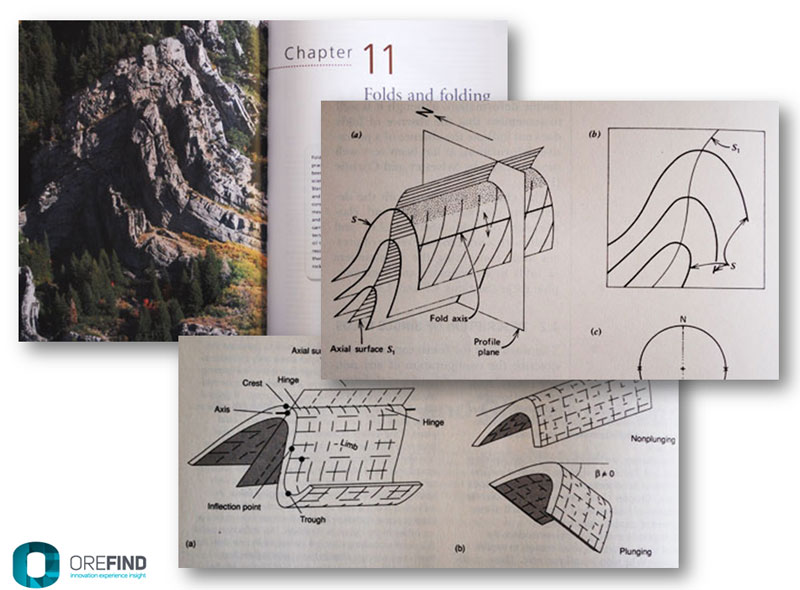 Figure 8. Most geology text books show pictures of antiforms when they introduce the concept of folding.
Figure 8. Most geology text books show pictures of antiforms when they introduce the concept of folding. Implications of the ‘Fold test’
I’m suggesting that the antiform bias that we geologists have is a consequence of unintentional brainwashing, and a sure sign of brainwashing is that the those who are brainwashed have no idea that they were brainwashed.
If this extreme bias that we see in our geological community is due to passive and unintended brainwashing, then consider the outcome if a message is pounded into us intentionally and repeatedly by an enthusiastic and charismatic academic or industry leader. These ideas could be mineralisation models (eg Shear-zone Hosted Gold, SEDEX, VMS), or some geological theory (eg Plate Tectonics, Expanding Earth).
This brainwashing is no different to that used in product advertisements—after a while you become oblivious to what you are told repeatedly, and eventually it just becomes part of your language and even thinking. You don’t question it, but simply accept it, and the ideas are interwoven with your beliefs, without you ever realising that you were brainwashed in the first place. Any ideas that are counter to what you are told are rejected without any rigorous testing. Everyone else exposed to the same brainwashing messages is in the same boat and everyone agrees with each other.
But what if the message you were told for decades was actually wrong? It would be a difficult job to turn your thinking around because you’ve been told the message over and over again. It just becomes part of you so you vigorously defend it, even if it was an idea invented by someone else. It’s been in your system for so long that it simply becomes part of your thinking. In fact, it becomes part of the community so when the bias is pointed out (such as the fold bias), you don’t quite grasp the extreme (9/10!) nature of it. With this sort of bias and entrenched thinking, it’s not surprising that major scientific breakthroughs don’t happen very often.
This is the scary implication of the fold bias if extrapolated to other parts of our lives, but before you get too scared, I dare you to try out ‘The System’ and ask an unsuspecting geologist the fold question:
“Imagine a single fold profile. Do you see a synform or an antiform?” Acknowledgement
Dr Stefan Revets for discussions and help with the statistics in the original 1998 UWA study.
References
Chadwick, P.K., 1975, A psychological analysis of observation in geology. Nature 256, p. 570-573.
Sliver, N., 2012, The Signal and the Noise : The Art and Science of Prediction. Penguin Books, London.